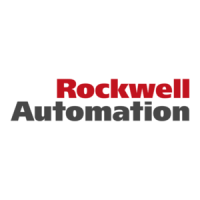Do you have a question about the Rockwell Automation 2080-LC50-48QWB and is the answer not in the manual?
| Brand | Rockwell Automation |
|---|---|
| Model | 2080-LC50-48QWB |
| Category | Controller |
| Language | English |
Details the economical brick-style controllers with embedded inputs/outputs and expandable features.
Describes the features and status indicators of Micro830 controllers.
Details the features and status indicators of Micro850 controllers.
Outlines the features and status indicators of Micro870 controllers.
Introduces Connected Components Workbench software for programming, configuration, and HMI design.
Details features for making changes to a running controller project without going to program mode.
Explains RMC as a productivity feature allowing logic modifications in run mode without disconnecting.
Lists limitations when using the Run Mode Change feature, such as configuration changes.
Describes RMCC for reusing programs with multiple controllers by changing address configuration during run mode.
Explains how to use RMCC with Modbus RTU by setting the serial port to Modbus slave role.
Details using RMCC with EtherNet/IP, requiring a static IP address.
Highlights important safety considerations for proper system installation.
Emphasizes locating the main power disconnect for quick and easy access.
Provides mounting dimensions for Micro830, Micro850, and Micro870 controllers, excluding feet or latches.
Offers recommendations for wiring, including spacing, conduit, and labeling.
Discusses reducing the effects of environmental noise through proper installation and grounding.
Lists communication protocols supported by Micro830, Micro850, and Micro870 controllers.
Details the default communication protocols for serial and Ethernet channels for DNP3 Slave configuration.
Explains the Micro800 scan cycle, program naming conventions, and program execution order.
Discusses factors affecting controller load and performance, including interrupts and communication.
Details how variables are retained after a power cycle across different Micro800 controller models.
Shows available memory on Micro800 controllers for program steps and data bytes.
Details EtherNet/IP network functionality, including topologies, communication rates, and IP address detection.
Explains implicit messaging to EtherNet/IP devices using generic or predefined tags.
Guides on adding PowerFlex 520/5100 drives and configuring their properties.
Describes the properties available in the New Module/Configure Module window.
Explains predefined tags for PowerFlex 520-series and Kinetix 5100 drives to simplify programming.
Details the use of predefined UDFBs for simple drive control applications.
Lists possible connection faults and their corrective actions for EtherNet/IP.
Explains PTO functionality for generating pulses for precise control of position and velocity.
Details the elements of the Micro800 motion control feature and the necessary steps to use it.
Describes key components of motion control: Pulse Train Outputs, Axis, Motion Function Blocks, and Jerk.
Lists error codes shared by all motion control function blocks and axis status errors.
Guides on adding, configuring, updating, deleting, and monitoring motion axes.
Describes the MC_Home function block for performing the "search home" sequence.
Restricts access to programming software connections by requiring a password for upload and download.
Provides workflows for uploading, debugging, and downloading to a password-protected controller.
Details backing up and restoring a controller's project to a memory plug-in device.
Outlines steps to recover access if a controller password is lost, often involving firmware update.
Introduces microSD card support for project backup, data logging, and recipes on Micro800 controllers.
Explains project backup and restore operations using microSD cards, initiated manually or automatically.
Guides on flashing firmware using Connected Components Workbench software or a microSD card.
Details setting, changing, and clearing controller passwords using Connected Components Workbench software.
Demonstrates making small logic changes to a running project and testing them on the controller.
Describes the STI mechanism for solving time-critical control requirements.
Lists possible error codes for Micro800 controllers and recommended recovery actions.
Provides specific steps for resolving recoverable and non-recoverable faults.
Offers a diagnostic model with common questions to troubleshoot system problems.
Provides steps and recommendations for performing the autotune process.
Provides a formula and examples for calculating total power consumption.












